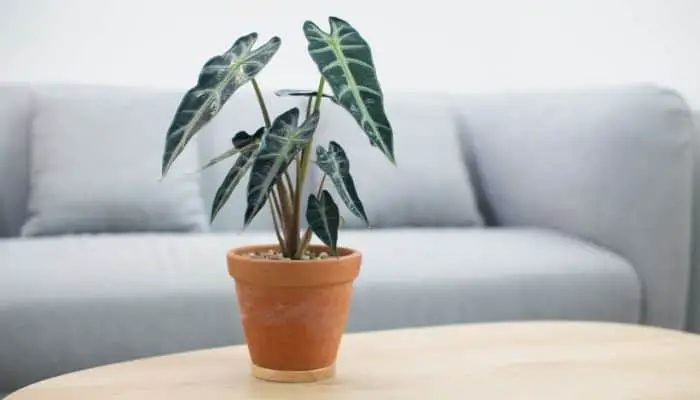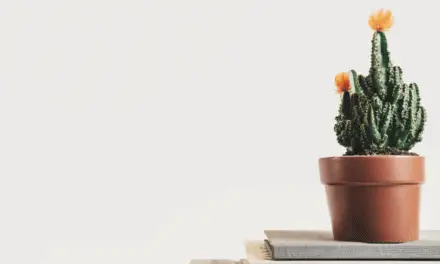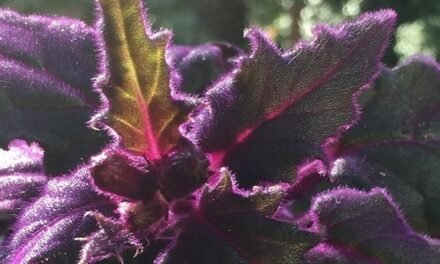Alocasia is a family of tropical plants that can be found growing in gardens and homes around the world, as long as temperatures do not dip too low.
They can also tolerate low light conditions and this leads some to believe that these plants might be good to last through the winter.
But Alocasias are warm-weather plants and can be difficult to keep healthy during the winter months.
Table of Contents
Do Alocasia Die In Winter?

Alocasias are very sensitive to the cold and will go dormant in winter if temperatures drop below 50 degrees F for extended periods. And if temperatures dip to freezing and expose the plant to frost it will most likely die.
But it is possible to dig up the Alocasia’s tubers before the frost gets to them (at least some types) and it can survive by potting it or storing it in a place that is cool and dry.
Then, when spring comes back around, you can take them back outside and replant them.
Tubers are underground systems that store nutrients for some – but not all – Alocasia plants.
Some of the tubers live a very long time and can become very large.
And if your Alocasia is a potted houseplant, you’ll need to keep the temperature above 60 degrees F and keep it well away from cold draughts and air-conditioning if you want it to stop it going dormant or dying.
Also Read: Why Does My Purple Passion Plant Have White Spots? (Explained)
How To Care For Your Dormant Alocasia In Winter
The care your Alocasia will need in the winter will depend on whether you want to let it go dormant or not.
If the temperature drops below 50 F for an extended period then your Alocasia might go dormant for 2 to 3 months.
This means that your plant will stop growing and go into a type of hibernation.
Water Sparingly
When it goes into this state you must move it to a warm plane in your home and water it less often.
Overwatering at this time can be detrimental.
With soggy soil, they can easily get fungal infections and root rot.
This is particularly important during the winter because they stop growing and just don’t need as much water as they would in spring and summer when they are putting more energy into growing.
During dormancy, your Alocasia may drop all its leaves and will only need a little bit of water once every 2 or 3 weeks until it begins to exit its dormant state following 2 to 3 months.
When To Move Alocasia Tubers Inside?
Many types of Alocasia grow their leaves from tubers that live below the surface of the soil.
Frosty weather will kill the tubers so you should consider moving them in from your garden when the weather starts getting cooler, but, before it starts to frost.
You’ll find these little round-shaped bulbs (tubers) in the soil around the roots of the plant and sometimes attached to the roots.
Carefully remove the tuber with roots from the plant and give it a little squeeze.
If it feels firm it should be fine but if it feels soft, it may already be rotting and not worth trying to do anything with.
You can plant the tuners directly into some well-drained soil.
It’s important that the soil you use does not hold onto water and cause the tubers to rot.
Give them a little water about once a week and keep an eye out for new growth.
How To Prevent Your Alocasia From Going Dormant During The Winter?
If the temperature is allowed to drop, Alocasias will go dormant during the winter, all the leaves will fall off and die and all you will see is a tiny little stump where the Alocasia once was.
This is completely normal, but it doesn’t mean you can’t do something to stop it from happening to your potted plant.
To stop your Alocasia from entering dormancy, you just need to follow a few steps.
To stop dormancy, the plant just requires some extra warmth, humidity, and bright light.
Humidity And Light
Providing plenty of humidity for your Alocasia is important.
To give it that humidity, you can keep it in a bright bathroom, get a humidifier or keep it close to other plants that have heavy foliage and like to sweat.
Although these plants can tolerate low-light conditions, giving them plenty of sunlight during the winter months will help to breathe life into them.
Keep it in a bright and humid room.
You can even give your Alocasia a couple of hours of direct weaker morning sunlight.
But I wouldn’t expose it to full afternoon sun as it might get sunburned.
The Right Soil
People run into a lot of problems with Alocasia when the soil being used retains too much water.
It is recommended to use an equal-part mix of houseplant soil, perlite and peat moss.
This mixture will hold onto a slight bit of moisture while providing enough drainage for your plant.
This will keep the plant happy.
To keep the plant and soil warmer, you can water it less in winter.
If not dormant, allow the top 2 or 3 inches of soil to dry out between watering so that the plant doesn’t become waterlogged.
During the winter, Alocasia will use the water in the soil more slowly because they won’t be growing much.
Dry soil gets warmer as well due to air pockets in the soil, which will insulate the root of your plant, thus keeping it a little warmer.
Alternatively, you can use methods such as heat mats, or moving your Alocasia into a greenhouse, but this will all depend on the climate of the area you live in.
Should I Mist My Alocasia?
Alocasia plants like high humidity but you should avoid misting them because it can cause the onset of disease.
Many experts believe that the benefits of misting are minimal and only boost humidity for your plant for a very short period of time.
It’s okay to mist plants that are not sensitive to having their leaves wet.
But Alocasia are sensitive to having water sit on their leaves so when weighing up the pros and cons, it’s best to avoid misting these plants.
Using a humidifier is the most effective way to raise humidity for your Alocasia.
Final Thoughts
Alocasia plants are certainly not the easiest to care for in winter.
But if you keep the temperature above 60 degrees F, provide them plenty of humidity and lots of bright indirect sunlight, your Alocasia will have every chance of thriving during the winter months




